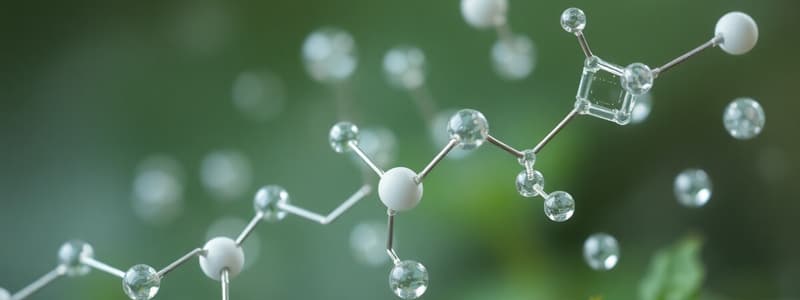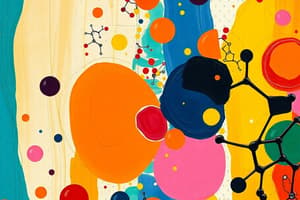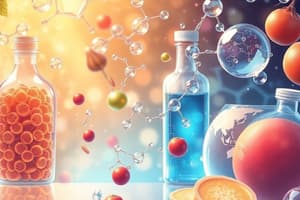Podcast
Questions and Answers
What blood type results from the absence of both GalNAc and galactose?
What blood type results from the absence of both GalNAc and galactose?
- A
- B
- AB
- O (correct)
Which type of glycosidic bond is found in cellulose?
Which type of glycosidic bond is found in cellulose?
- Beta (1->4) (correct)
- Alpha (1->4)
- Beta (1->6)
- Alpha (1->6)
What is the primary function of intestinal disaccharidases?
What is the primary function of intestinal disaccharidases?
- Convert polysaccharides into disaccharides.
- Break down proteins into polypeptides.
- Transport glucose into mucosal cells.
- Convert disaccharides into monosaccharides. (correct)
Which transporter is responsible for absorbing fructose in the intestine?
Which transporter is responsible for absorbing fructose in the intestine?
A prolonged blood glucose concentration of 9 mM (162 mg/dL) is most likely to cause which condition?
A prolonged blood glucose concentration of 9 mM (162 mg/dL) is most likely to cause which condition?
Which characteristic of amylopectin allows for faster energy production compared to amylose?
Which characteristic of amylopectin allows for faster energy production compared to amylose?
What is the primary distinction between proteoglycans and glycoproteins in terms of their composition?
What is the primary distinction between proteoglycans and glycoproteins in terms of their composition?
What is the primary function of glycosaminoglycans (GAGs) in the extracellular matrix?
What is the primary function of glycosaminoglycans (GAGs) in the extracellular matrix?
The covalent attachment of oligosaccharides to a protein is known as:
The covalent attachment of oligosaccharides to a protein is known as:
Which cellular process is NOT a typical function of membrane-bound glycoproteins?
Which cellular process is NOT a typical function of membrane-bound glycoproteins?
What determines whether a person has blood group A or B, according to the information provided?
What determines whether a person has blood group A or B, according to the information provided?
Which of the following best describes the structure of a proteoglycan?
Which of the following best describes the structure of a proteoglycan?
Where are glycoproteins commonly found?
Where are glycoproteins commonly found?
What is the general formula for carbohydrates?
What is the general formula for carbohydrates?
Which of the following is a characteristic of all monosaccharides?
Which of the following is a characteristic of all monosaccharides?
What is the name of the bond that links two monosaccharides to form a disaccharide?
What is the name of the bond that links two monosaccharides to form a disaccharide?
Which of the following is classified as a storage polysaccharide?
Which of the following is classified as a storage polysaccharide?
If a monosaccharide is classified as a ketopentose, what does this indicate about its structure?
If a monosaccharide is classified as a ketopentose, what does this indicate about its structure?
Which of the following best describes the relationship between glucose and fructose?
Which of the following best describes the relationship between glucose and fructose?
Which of the following statements regarding modified monosaccharides is true?
Which of the following statements regarding modified monosaccharides is true?
What monosaccharides comprise the disaccharide sucrose?
What monosaccharides comprise the disaccharide sucrose?
Which structural polysaccharide is made of N-acetyl glucosamine?
Which structural polysaccharide is made of N-acetyl glucosamine?
What is the role of glycogenin in glycogen synthesis?
What is the role of glycogenin in glycogen synthesis?
Flashcards
Carbohydrates
Carbohydrates
Organic compounds containing a carbonyl group (aldehyde or ketone) and multiple hydroxyl groups.
Isomer
Isomer
A compound with the same chemical formula but a different arrangement of atoms.
Monosaccharide
Monosaccharide
A single sugar molecule, like glucose or fructose.
Aldose
Aldose
Signup and view all the flashcards
Ketose
Ketose
Signup and view all the flashcards
Disaccharide
Disaccharide
Signup and view all the flashcards
Polysaccharide
Polysaccharide
Signup and view all the flashcards
Glycogen
Glycogen
Signup and view all the flashcards
Cellulose
Cellulose
Signup and view all the flashcards
Digestion of Carbohydrates
Digestion of Carbohydrates
Signup and view all the flashcards
Amylopectin
Amylopectin
Signup and view all the flashcards
Amylose
Amylose
Signup and view all the flashcards
Proteoglycan
Proteoglycan
Signup and view all the flashcards
Glycosaminoglycans (GAGs)
Glycosaminoglycans (GAGs)
Signup and view all the flashcards
Glycoprotein
Glycoprotein
Signup and view all the flashcards
Glycosylation
Glycosylation
Signup and view all the flashcards
Membrane-bound glycoproteins
Membrane-bound glycoproteins
Signup and view all the flashcards
Extracellular matrix (ECM) glycoproteins
Extracellular matrix (ECM) glycoproteins
Signup and view all the flashcards
Carbohydrate Digestion
Carbohydrate Digestion
Signup and view all the flashcards
Glucosidase Enzymes
Glucosidase Enzymes
Signup and view all the flashcards
Alpha Glycosidic Bond
Alpha Glycosidic Bond
Signup and view all the flashcards
Beta Glycosidic Bond
Beta Glycosidic Bond
Signup and view all the flashcards
SGLT-1
SGLT-1
Signup and view all the flashcards
Study Notes
Carbohydrates Overview
- Carbohydrates are a group of carbonyl compounds (aldehydes or ketones) containing several hydroxyl groups.
- Their general formula is (C.H₂O)n
- Carbohydrates can change in some conditions (e.g., less oxygen, more carbon, more nitrogen)
Carbohydrate Objectives
- Recognize the general structure of carbohydrates
- Classify carbohydrates
- Recognize disaccharides and polysaccharides
- Explain carbohydrate-modified protein structures and their function
- Explain carbohydrate digestion
Carbohydrate Structure
- Carbohydrates contain carbonyl groups (aldehyde or ketone) and hydroxyl groups.
- Aldehydes are where the carbonyl group is at the end of the carbon chain.
- Ketones are where the carbonyl group is in the middle of a carbon chain.
- Isomers are molecules with the same chemical formula but different structures.
- Fructose and glucose have the same formula (C₆H₁₂O₆), but different structures.
Carbohydrate Classification
- Classification is based on the number of sugar units:
- Monosaccharides (single sugar unit)
- Disaccharides (two sugar units)
- Oligosaccharides (a few sugar units)
- Polysaccharides (many sugar units forming polymers)
- The suffix "-ose" is added to the names of most carbohydrates.
Monosaccharides
- Classified as aldoses or ketoses based on the carbonyl group. (Aldehyde or Ketone group)
- Classified by the number of carbon atoms (trioses, tetroses, pentoses, hexoses, heptoses, nonoses)
- Examples include glucose, fructose, galactose, ribose, and deoxyribose.
- Some monosaccharides are isomers (same chemical formula, different structure).
Disaccharides
- Formed by the combination of two monosaccharides via a glycosidic bond.
- Examples include maltose (glucose + glucose), lactose (galactose + glucose), and sucrose (glucose + fructose).
Polysaccharides
- Polymers formed by many monosaccharides linked by glycosidic bonds.
- Examples include starch, glycogen, and cellulose.
- Starch and glycogen are storage polysaccharides.
- Cellulose is a structural polysaccharide.
Protein-Carbohydrate Structures
- Carbohydrates and proteins can be combined to form glycoproteins.
- Carbohydrates can be attached to proteins through glycosylation.
- Proteoglycans are proteins that have many glycosaminoglycans (GAGs) attached.
- Glycosylation is a common posttranslational modification of proteins.
Carbohydrate Digestion
- Digestion starts in the mouth with enzymes breaking down glycosides.
- Digestive enzymes break down polysaccharides into monosaccharides.
- Humans cannot digest cellulose due to the structure of the glycosidic bond.
- Monosaccharides are absorbed into the bloodstream.
Carbohydrate Absorption
- Sodium-dependent glucose co-transporter 1 (SGLT1) absorbs glucose and galactose.
- GLUT-2 absorbs fructose.
- These transporters move the sugars from the intestine into the bloodstream.
Carbohydrate Metabolism
- Blood glucose is important for cellular energy.
- The blood glucose concentration must be maintained within a specific range for healthy function.
Studying That Suits You
Use AI to generate personalized quizzes and flashcards to suit your learning preferences.
Related Documents
Description
This quiz provides an overview of carbohydrates, focusing on their structure, classification, and functions. Participants will learn about the general formula, types of carbohydrates, and their roles in digestion. Get ready to explore the fascinating world of carbohydrates and their biochemical significance!




